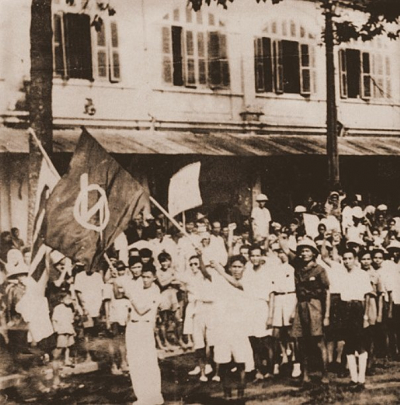The Nguyn dynasty (Ch Nm: , Vietnamese: Nh Nguyn; Ch Hn: , Vietnamese: Nguyn triu) was the last Vietnamese dynasty, which ruled the unified Vietnamese state largely independently from 1802 to 1884. During its existence, the empire expanded into modern-day southern Vietnam, Cambodia, and Laos through a continuation of the centuries-long Nam tin and SiameseVietnamese wars. After 1883, the Nguyn emperors ruled nominally as heads of state of the French protectorates of Annam and Tonkin until the final months of WWII; they later nominally ruled over the Empire of Vietnam until the Japanese surrender.
The Nguyn Phc family established feudal rule over large amounts of territory as the Nguyn Lords by the 16th century before defeating the Ty Sn dynasty and establishing their own imperial rule in the 19th century. The dynastic rule began with Gia Long ascending the throne in 1802, after ending the previous Ty Sn dynasty. The Nguyn dynasty was gradually absorbed by France over the course of several decades in the latter half of the 19th century, beginning with the Cochinchina Campaign in 1858 which led to the occupation of the southern area of Vietnam. A series of unequal treaties followed; the occupied territory became the French colony of Cochinchina in the 1862 Treaty of Saigon, and the 1863 Treaty of Hu gave France access to Vietnamese ports and increased control of its foreign affairs. Finally, the 1883 and 1884 Treaties of Hu divided the remaining Vietnamese territory into the protectorates of Annam and Tonkin under nominal Nguyn Phc rule. In 1887, Cochinchina, Annam, Tonkin, and the French Protectorate of Cambodia were grouped together to form French Indochina.
The Nguyn dynasty remained the formal emperors of Annam and Tonkin within Indochina until World War II. Japan had occupied Indochina with French collaboration in 1940, but as the war seemed increasingly lost, overthrew the French administration in March 1945 and proclaimed independence for its constituent countries. The Empire of Vietnam under Emperor Bo i was a nominally independent Japanese puppet state during the last months of the war. It ended with Bo i's abdication following the surrender of Japan and August Revolution by the anti-colonial Vit Minh in the August 1945. This ended the 143-year rule of the Nguyn dynasty.
The August Revolution (Vietnamese: Cách-mạng tháng Tám), also known as the August General Uprising (Tổng khởi-nghĩa cướp chính-quyền tháng Tám), was a revolution launched by Hồ Chí Minh's Việt Minh (League for the Independence of Vietnam) against French and Japanese colonial rule in Vietnam, on 19 August 1945.
Within two weeks, forces under the Việt Minh had seized control of most rural villages and cities throughout Northern, Central and Southern Vietnam, including Hanoi, where President Hồ Chí Minh announced the formation of the Provisional Democratic Republic, Huế, Saigon, except in townships Móng Cái, Vĩnh Yên, Hà Giang, Lào Cai, Lai Châu.However, according to Vietnamese documents, Việt Minh, in fact, seized control of Vietnam. On 2 September 1945, Ho Chi Minh declared Vietnamese Independence. The August Revolution sought to create a Việt Minh unified regime for the entire country.
19 August is considered as the unofficial Victory over Japan Day in Vietnam.

1945Aug, 30
The August Revolution ends as Emperor Bảo Đại abdicates, ending the Nguyễn dynasty.
Choose Another Date
Events on 1945
- 23Feb
Manila
World War II: The capital of the Philippines, Manila, is liberated by combined Filipino and American forces. - 23Feb
History of Poland (1939-45)
World War II: Capitulation of German garrison in Poznań. The city is liberated by Soviet and Polish forces. - 25Feb
Turkey
World War II: Turkey declares war on Germany. - 9Mar
Atomic bombings of Hiroshima and Nagasaki
World War II: The first nocturnal incendiary attack on Tokyo inflicts damage comparable to that inflicted on both Hiroshima and Nagasaki five months later. - 30Aug
Douglas MacArthur
The Supreme Commander of the Allied Forces, General Douglas MacArthur lands at Atsugi Air Force Base.

 English
English  español
español  français
français  português
português  русский
русский  العربية
العربية  简体中文
简体中文 